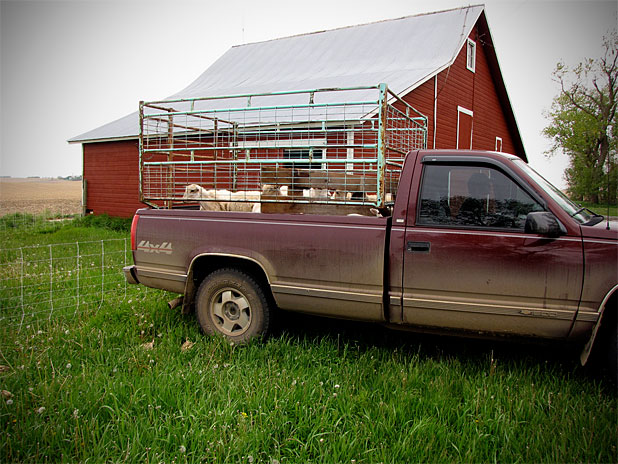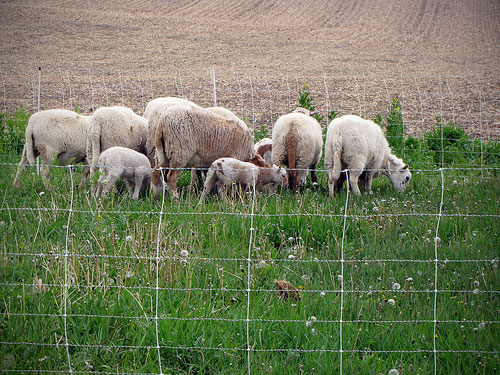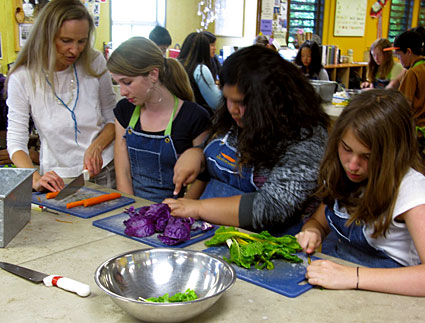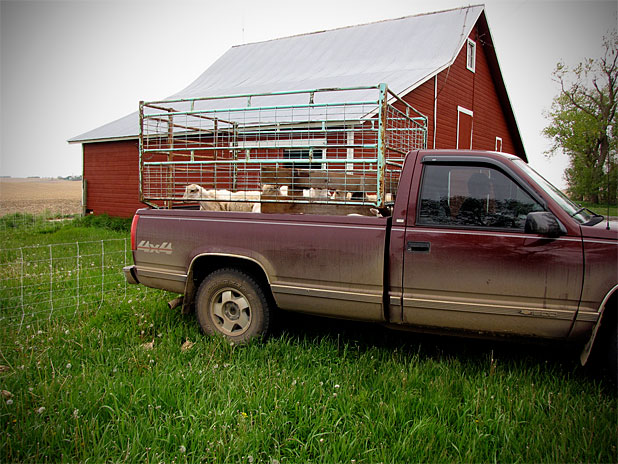 Sheep ready to be unloaded into their new pen from the borrowed livestock rack.(Steph Larsen photos)My first experience working directly with cows on a daily basis was not a particularly good one. It was 7 years ago on an organic dairy farm in England, and while most of the 99 Ayrshires were docile, the well-placed kicks I got from the mean ones were enough to convince me of two things — that I’d rather not milk animals, period, and that cows are not my first choice for livestock.
Sheep ready to be unloaded into their new pen from the borrowed livestock rack.(Steph Larsen photos)My first experience working directly with cows on a daily basis was not a particularly good one. It was 7 years ago on an organic dairy farm in England, and while most of the 99 Ayrshires were docile, the well-placed kicks I got from the mean ones were enough to convince me of two things — that I’d rather not milk animals, period, and that cows are not my first choice for livestock.
After the dairy experience, I worked on a different farm with sheep. I found them a vast improvement: when a sheep steps on your foot or head-butts your leg, it doesn’t really hurt.
So a few weekends ago, we brought home 13 Katahdins.
Katahdins are a breed of hair sheep, meaning that they shed their fleece in the spring like a dog or a horse instead of needing to be sheared. Since the price of wool is so low these days, having to shear can become an added cost instead of an added value. We plan to graze the sheep and use them for meat, so Katahdins were a good choice. They’re also hardy and good mothers, both of which cut down on the labor required. Katahdins are not very common, but luckily through some networks within our community, we know a couple who raises them only 60 miles from us.
There were several important tasks to complete before we brought our sheep home, the main two being fencing and transportation. Sheep are infamous for getting out of whatever fence you set up, so we borrowed some electronet from my partner’s father. Electronet is easy to move after the grass is eaten, and the gaps are too small for lambs to fit through if it’s electrified.
We spent a good part of Saturday setting up the fence and testing the electric current, then finding the places where the strands were broken and mending them. Because the small electric wires are interwoven with plastic, you can’t just tie two pieces together. In order to splice two strands, you have to separate the wires from the plastic and then twist the wires together.
 Sheep safely ensconced in their penIt was a day of lessons. I learned how to hop over the fence while it’s on without getting shocked — which, as it’s between 4,000 and 7,000 volts, is not something I am eager to experience — and our dog Arrow found that sniffing the fence gets him zapped. We’ll see if he remembers this.
Sheep safely ensconced in their penIt was a day of lessons. I learned how to hop over the fence while it’s on without getting shocked — which, as it’s between 4,000 and 7,000 volts, is not something I am eager to experience — and our dog Arrow found that sniffing the fence gets him zapped. We’ll see if he remembers this.
Figuring out how to transport a dozen sheep was an exercise in community networking. We were looking for a livestock rack, which fits in the bed of a pickup truck and is tall enough to make sure the sheep can’t jump or fall out. Few of our neighbors have livestock anymore, so when we asked around, all we found were big trailers. While friends were very generous to offer them, they were too big — the sheep would have too much space to jostle around. Still, I feel lucky: the resources and knowledge I need are all around me, I just have to know who to ask.
Finally, in a chat with one of my neighbors, I jogged his memory and he remembered a rack in a pasture his father rents that hadn’t been used in years. It was exactly what we were looking for. Moments like this make me think that half the steel in the Midwest is stashed unused and rusting on the edges of pastures or in the groves around houses.
As we hoisted the rack onto the truck, I heard about the history of the homestead we were on — who lived there, which building had been a meat locker after they got electricity to the farm, and how the house fell into disrepair after the children moved away. Where are the oral historians when you need them? Rural communities have such rich histories, but rarely are they written anywhere. They now exist only in the minds of the people who live there, and while the best stories get handed down through generations, as more and more people move away, they are lost.
Besides the sheep, who are now bedded down in their pen, the most valuable things I gained this weekend were new ideas. The farmers who sold us the sheep have made incredible economical innovations: their chicken brooder is an old van with the seats taken out, their chicken waterers and nesting boxes are 5-gallon pails with holes cut in them. It makes me wonder what problems I can solve on my farm, using cheap materials that others might throw away.
I’m starting to see that having a farm is about using what you’ve got to fix the problem you have. Creativity with a distinct purpose. It’s easier to be creative in a community with a strong foundation of other people’s ideas on which to draw for inspiration. And although I don’t need much encouragement, this weekend has strengthened my ambition to build — and rebuild — vibrant rural communities, so more new farmers can be creative and thrive.




